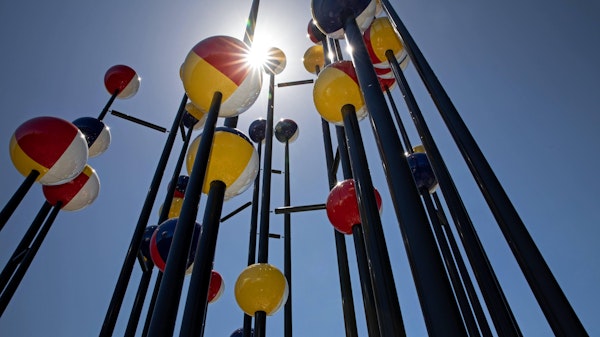
Public art
McClelland manages a range of public art commission projects for public and private partners, providing expertise in artist engagement, development and delivery of major sculpture commissions.

Three significant sculptures from Arts Centre Melbourne’s Public Art Collection have found a new temporary home at McClelland, during the Melbourne Arts Precinct Transformation.
Rhythms of Life, Family of Man I, Family of Man II, formerly located around Arts Centre Melbourne’s Theatres building, were installed yesterday at McClelland as part of a long-term loan as Arts Centre Melbourne undergoes significant updates to its buildings and public space.

Bunurong Fieldwork Residency
McClelland is calling for expressions of interest from First Nations artists to join a residency program aimed at developing skills and capacity in public art and delivering major creative outcomes.
The Bunurong Fieldwork Residency at McClelland will enable four First Nations artists or artist teams to reside in McClelland’s studio cottage over a period of six to twelve weeks each, developing detailed concept proposals for a permanent site-specific public artwork. While in residence, each artist or team of artists will be supported by McClelland to engage with Bunurong history, culture and community.
McClelland will provide accommodation, artist and travel fees, and a stipend for four artists or artist teams. In consultation with the Bunurong Land Council Aboriginal Corporation (BLCAC) and McClelland, workshops will provide the selected artists with opportunities for skills development in public art and collaborative, cross-cultural practices.
For more information please download the Bunurong Fieldwork Residency Program at McClelland EOI here
This project is supported by the Bunurong Land Council Aboriginal Corporation and Service Stream, and has been assisted by the Australian Government through the Australia Council for the Arts, its arts funding and advisory body.

Sound Shell sculpture at Karingal Hub
Sound Shell, located at Karingal Hub's Town Square was unveiled to the public on Wednesday 21 September 2022.
Australian artist and Mornington Peninsula resident, Christabel Wigley, was awarded the public artwork commission after impressing McClelland, Karingal Hub and ISPT representatives with her Sound Shell concept. Sound Shell takes the form of a Turbo or Turban shell, which is commonly found on the Mornington Peninsula and culturally significant to the Bunurong people of the Karingal area.
The sculpture features a unique soundscape which has been designed by Hayden Ryan to capture the origins of the land. This includes bird calls, audio of the local Bunurong language spoken by Uncle Mik Edwards and N’Arweet Dr Caroline Briggs AM, and ocean sounds from Port Phillip Bay.

Western Roads Upgrade Commission
Jon Campbell, Backyard, 2021
The Western Roads Upgrade project, the biggest single investment in Melbourne’s suburban road network, was delivered by Major Road Projects Victoria and the Netflow consortium as part of a Public Private Partnership, which includes maintaining a 260-kilometre arterial road network from Footscray to Werribee for an additional 20 years. Jon Campbell's Backyard, the result of an independent commission selection process run by McClelland, and is installed at the Duncans Road exit on the Princes Freeway in Werribee.
Backyard represents a stylised pop version of Campbell’s childhood backyard in the western suburb of Altona. A linear, multi-coloured design, like a billboard floating in space, Backyard invites viewers to reflect on their own environment and the spaces they inhabit.
Born in Northern Ireland in 1961, Campbell moved to Australia in 1964. He lives and works in Melbourne. His practice spans sculpture, painting, drawing, printmaking, and music, in a contemporary Australian pop style. He often works with text and humour to highlight Australian slang and vernacular phrases, and what these reveal about contemporary Australian culture and society.
Campbell notes that 'The backyard was a site of influential activity in my upbringing, playing cricket, family barbeques and birthdays. It was a space in which to dream and allowed me as a youngster to imagine hitting the winning runs or kicking the winning goal ... There is a myth attached to the backyard and a strong desire to have one. Maybe the backyard is not everyone’s dream, but as a space for connection, contemplation and shared activity it remains a desirable and aspirational goal of suburban Melbourne.'